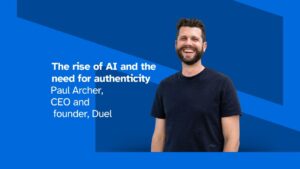By James A. Ingram, CEO of Splashlight & Telmar
I don’t work in advertising. I’m not a scientist, either. So what qualifies me to talk about the way in which technology, and especially artificial intelligence, is going to affect marketing and advertising in the future?
Well, over the last few years, my diverse interests, professional and personal, have converged into an exploration of the interface between technology and the human condition. Through my podcast, Creative Intelligence, I’ve met and interviewed people from across the technological and ethical spectrum, and we’ve had incredibly wide-ranging discussions about AI and architecture, artificially -created art, adaptive high-tech fashion, the ethics of data collection and retention and, to return to the matter at hand, technology and marketing.
The great strength of AI lies in what are referred to as “the 3 Ds”: dirty, dull and dangerous. These represent the tasks which we are readiest to assign to AI, and which it is most suitable to perform. The freedom from these tasks allows the human element in the machine — people — to devote themselves to higher-level, more conceptual pursuits.
AI-embedded tools can take away a lot of the strain in email marketing, for example, compiling and analysing vast amounts of data, assessing subject lines and doing all those grinding tasks with which interns are so familiar. You can see instantly that this isn’t necessarily transformative, but it’s a classic example of the theory of marginal gains: small, incremental improvements in a process which, when considered together, actually represent a significant step forward.
I want to stop for a moment to consider marginal gains, because I think it’s a really interesting concept and could be very important in the future of technology-driven marketing, and in the wider world of AI. It’s a simple enough idea, but it’s probably best known for its implementation by Sir Dave Brailsford, the Performance Director of British Cycling.
When he took over the team, he broke down the process of winning into small, individual parts: aerodynamics, cleanliness, health and wellbeing, technique… the list goes on. None of these items on its own was the critical difference, the winning secret, but if you make a 1% improvement in all of these, then the cumulative difference can be huge. The result? Britons dominate world cycling and have won the Tour de France again and again and again.
Defining the purpose of AI
As with cycling, so with any other complicated process, like marketing. If you break it down into individual components, you can then address improving and refining each of them in turn, creating, overall, a greatly improved marketing efforts. This brings us to a much more fundamental question which was posed by one of my podcast guests: what do businesses want AI to do? What is it for?
Is it simply a tool to improve the process in lots of little ways, to provide overall cumulative change, or is it an attempt to seize the initiative over your competitors, to gain the “unfair advantage,” as motor racing hero Mark Donohue used to say? I leave that as a genuinely open question; I don’t have an easy answer, but I’d very much like to hear what other people think.
There is one more concrete suggestion I can make, though. That’s about managing the interface between the growing technology as it becomes more sophisticated, and the ultimate user, the customer.
The birth of digital anthropology
This is, I believe, going to be the province of a new discipline, a combination of the close study of human behavior individually and in groups, anthropology, and data science. The idea I’ve been exploring for some years now is creating a set of skills, an academic discipline, to sit at this interface — digital anthropology
Digital anthropology will be a vital tool for businesses in adopting and adapting artificial intelligence to utilise its potential for marketing. Its practitioners will be the sherpas of this new approach, synthesising existing skill sets to create something new.
They will teach us what metrics we should collect and measure, what those measurements mean, how the data can be collected and how to handle it efficiently, safely and ethically once we possess it. It will be a tool we can deploy to effect so many different endeavors, not just marketing, but also art, philosophy and design, to name a few.
I’ve raised as many questions as I’ve answered. My friends will tell you that’s not unusual when you talk to me. But marketing is changing, we can already see that, and the change will not only continue, it will speed up. Digital anthropology can be a safety belt, a rear-view mirror and a brake, all in one. Embrace it, and it will change your world.









